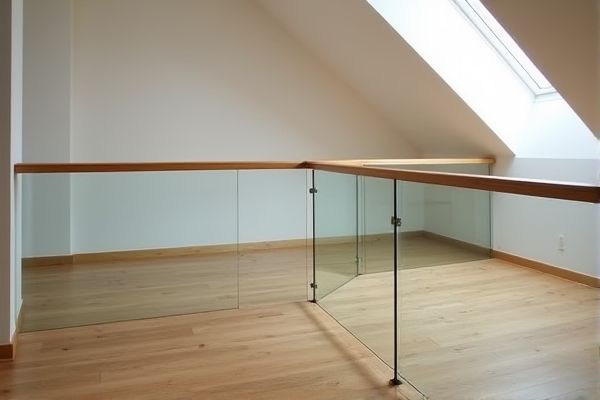
Attic glass railings offer a modern, transparent look that maximizes natural light and creates a sense of spaciousness, while wood railings provide a classic, warm aesthetic with customizable finishes and a tactile feel. Explore the detailed comparison to help you decide which railing suits your attic's style and functionality needs best.
Table of Comparison
| Feature | Attic Glass Railing | Wood Railing |
|---|---|---|
| Material | Tempered Glass panels with metal frames | Solid wood (oak, pine, cedar) |
| Visibility | Clear, unobstructed views | Opaque, blocks view |
| Durability | High resistance to weather, scratches, and corrosion | Prone to rot, warping, insects without maintenance |
| Maintenance | Low; occasional cleaning with glass cleaner | High; requires sanding, staining, or painting |
| Installation | Requires professional fitting for safety | DIY possible with carpentry skills |
| Safety | Tempered glass is shatter-resistant and safe | Sturdy but may splinter or weaken over time |
| Aesthetic Appeal | Modern, sleek, minimalistic | Traditional, rustic, warm feel |
| Cost | Higher upfront cost due to materials and labor | Generally lower initial cost |
| Environmental Impact | Recyclable glass and metal components | Renewable wood but may involve deforestation |
Introduction to Attic Railing Options
Attic railing options include glass and wood materials, each offering unique benefits for safety and aesthetics. Glass railings provide a modern, transparent look that maximizes light and space, ideal for contemporary designs. Wood railings offer warmth and traditional charm, with customizable finishes that complement various interior styles and Your personal touch.
Aesthetic Appeal: Glass vs. Wood
Glass attic railings offer a sleek, modern aesthetic that maximizes natural light and creates an open, airy feel, making your space appear larger and more contemporary. In contrast, wood railings provide a warm, timeless appeal with rich textures and customizable stains that suit traditional or rustic designs. Choosing between the two depends on your desired ambiance: glass for a minimalist, elegant look or wood for classic charm and natural warmth.
Durability and Longevity Comparison
Attic glass railings offer superior durability with weather-resistant materials that prevent warping, fading, and cracking, making them ideal for long-term use in various climates. Wood railings, while aesthetically warm, require regular maintenance such as sealing and painting to protect against moisture damage, rot, and insect infestation. Your choice between glass and wood railings should consider the balance between maintenance effort and the desired lifespan of your attic railing system.
Safety Features of Glass and Wood Railings
Glass railings offer superior safety with their sturdy tempered or laminated panels that resist impact and prevent accidental falls while maintaining clear visibility. Wood railings provide strength and durability, but they require regular maintenance to avoid splintering, cracking, or weakening that can compromise safety over time. Choosing glass or wood for your attic railing depends on your preference for modern, transparent protection or traditional, solid support with ongoing upkeep.
Maintenance Requirements and Upkeep
Attic glass railings require minimal maintenance, needing only occasional cleaning with a mild glass cleaner to prevent smudges and maintain transparency. Wood railings demand regular upkeep, including sanding, staining, or painting to protect against moisture, warping, and pests. You can save time and effort with glass railings, as they resist weathering and don't deteriorate like wood over time.
Cost Analysis: Glass Railing vs. Wood Railing
Glass railings typically incur higher upfront costs due to material expenses and professional installation, averaging between $150 to $300 per linear foot, while wood railings tend to cost $30 to $100 per linear foot depending on the wood type and craftsmanship. Maintenance costs for glass are generally lower because of easy cleaning and resistance to weather-induced wear, whereas wood requires regular staining or painting and may need repairs over time, increasing long-term expenses. Considering durability and aesthetic appeal, glass railings offer a cost-effective investment in modern attic designs despite the initial price difference.
Installation Process Differences
Attic glass railing installation requires precise measurements and specialized mounting hardware to securely anchor the transparent panels, often involving professional-grade tools and expertise for proper alignment and safety compliance. Wood railing installation is generally more straightforward, involving cutting, fitting, and fastening wooden balusters or panels with screws or nails, making it more accessible for DIY projects. Your choice affects installation time and complexity, with glass railings demanding meticulous handling due to weight and fragility compared to the more forgiving nature of wood.
Light Flow and Space Perception
Attic glass railings maximize light flow by allowing natural sunlight to pass through unobstructed, creating an open and airy atmosphere that enhances space perception. Wood railings tend to block light and create visual barriers, which can make attics feel smaller and more enclosed. Opting for glass railings increases brightness and fosters a sense of spaciousness essential for attic areas with limited dimensions.
Eco-Friendliness and Material Sustainability
Attic glass railings offer superior eco-friendliness due to their use of recyclable tempered glass and aluminum framing, minimizing environmental impact over time. Wood railings, while biodegradable and sourced from renewable forests, often involve deforestation and chemical treatments that can reduce sustainability. Choosing glass railings ensures long-term durability with minimal resource depletion, aligning closely with sustainable building practices.
Final Verdict: Choosing the Best Railing for Your Attic
Glass railings offer a sleek, modern aesthetic and maximize natural light in your attic, enhancing the sense of openness and space. Wood railings provide warmth, durability, and a classic look, often easier to customize with stains and finishes to match your existing decor. Your final decision should balance style preferences, maintenance requirements, and the visual impact you want to achieve in your attic space.
 homyna.com
homyna.com